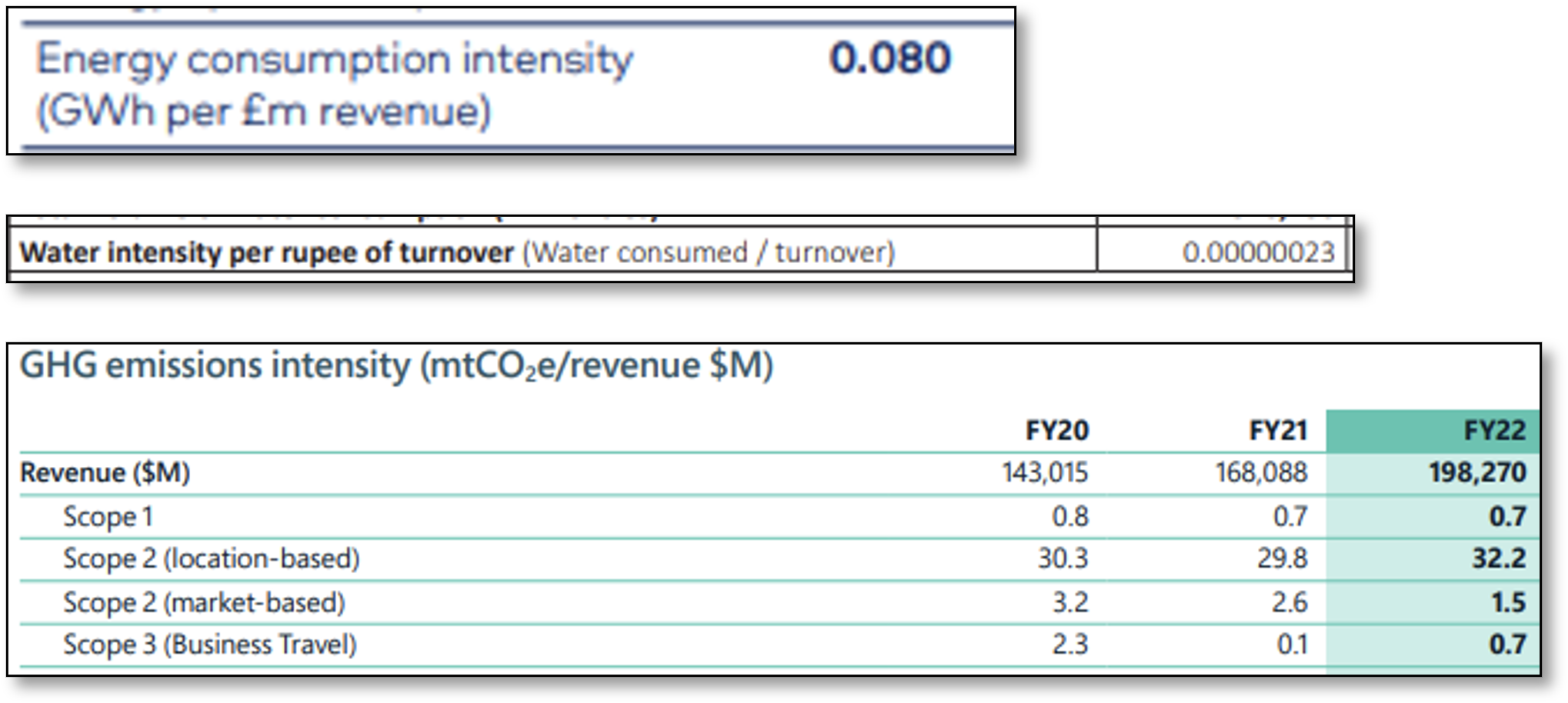This document is a review draft. Readers are invited to submit comments to the Best Practices Board.
Table of Contents
1 Introduction
Intensity ratios are specific metrics that normalise an environmental or social impact by a business activity metric, typically a financial performance indicator. For instance, "energy consumption per revenue unit" is an intensity ratio. It measures the amount of energy used to generate one monetary unit of revenue, offering a way to assess energy efficiency relative to the company's size and economic output. One of the primary advantages of using intensity metrics is their role in facilitating comparisons over different periods or against other companies in the same sector or of various sizes.
A number of examples from real-world ESG reports disclosing intensity ratios is shown in Figure 1
 Figure 1: Extracts from ESG reports disclosing intensity ratios
Figure 1: Extracts from ESG reports disclosing intensity ratiosConcepts like profit or emissions are represented with a single unit measure, such as a currency for profit or a physical unit for emissions. However, intensity metrics in ESG reporting are more complex as they involve a ratio of two different units. For example, an intensity ratio expressed as "Kilojoule Per Million Dollar Revenue" requires two units: "Kilojoule" and "Dollars", to be specified in the XBRL report.
The XBRL standard has introduced new data types and unit types to support the requirements of intensity measure reporting. This guide discusses modelling and tagging such intensity metrics using these new data and unit types.
2 Modelling and Tagging Intensity Metrics
Intensity metrics measured per monetary unit should be modelled in the taxonomy using the intensity metric data types. The intensity metric data types help validate that preparers use a correct unit of measurement for both the metric and the monetary value. Following are data types and units for modelling and tagging intensity metrics.
2.1 Energy per monetary unit
| Datatype | energyPerMonetaryItemType |
| Unit of Metric (Numerator) | All units that can be used for "energyItemType"; such as Gigajoule (GJ) and Kilojoule (kJ) |
| Unit of monetary value (Denominator) | Currencies used for monetary values |
| Example | Energy consumption intensity - 0.018 Gigajoules per million USD of net revenue |
| Unit for above example | GJ/$ |
2.2 Emissions per monetary unit
| Datatype | ghgEmissionsPerMonetaryItemType |
| Unit of Metric (Numerator) | All units that can be used for "ghgEmissionsItemType"; such as Metric tonnes of CO2 equivalent (tCO2e) |
| Unit of monetary value (Denominator) | Currencies used for monetary values |
| Example | Scope 1 emissions intensity - 0.00000098 tonnes CO2e per Euro of net revenue |
| Unit for above example | tCO2e/€ |
2.3 Volume per monetary unit
| Datatype | volumePerMonetaryItemType |
| Unit of Metric (Numerator) | All units that can be used for "volumeItemType"; such as Cubic Feet (ft³) and Gallons (gal) |
| Unit of monetary value (Denominator) | Currencies used for monetary values |
| Example | Water withdrawal intensity - 0.0000004 cubic metres per Japanese Yen of net revenue |
| Unit for above example | m³/ ¥ |
These dataypes are designed to capture ratios where the numerator is a physical quantity and the denominator is a monetary value.
For intensity metrics where the numerator and denominator are both physical quantities, such as "Energy consumption per product unit", it is recommended that taxonomy authors create custom datatypes. For reporting such intensity metrics preparers should use relevant units of measurement for the numerator and denominator. If the taxonomy author considers that the new data and unit type might have a broader application, it can be submitted for inclusion in the XBRL registries
3 Scaled intensity
Intensity metrics per monetary unit are often scaled for better readability. For example, a water consumption intensity of 0.004 cubic metres per million dollars of net revenue, when presented as cubic metres per dollar, would be 0.000000004, which is an insignificantly small number to comprehend.
In XBRL reports, physical quantities can be reported units with different scales, such as gigajoules, megajoules or kilojoules for energy, or tonnes, kilograms or grams for mass.
When monetary values such as "Revenue" or "Profit" are disclosed as scaled values, such as millions of dollars, they must be reported as unscaled values in the XBRL report. Inline XBRL reports use the "scale" factor to specify the scale of the presented figure, which transforms them into the correct, unscaled value when XBRL data is extracted.
When a scaled intensity metric is disclosed, the physical quantity in the numerator can be measured using scaled units available in the XBRL standard, but the denominator must be the unscaled currency. For example, a scaled intensity metric reported in "Gigajoules per million Euro of net revenue" must use units of "Gigajoules per Euro" in the XBRL report.
The scale factor must be applied to convert the presented value to the units required for the XBRL report.
The scale factor is expressed as a power of ten and denotes the amount that the presented figure must be multiplied by. For instance, 'Profit' presented as $15.32 million uses a scale factor of 6, resulting in a $15,320,000 value in the XBRL report. When monetary values are presented in a scaled format, they usually use a positive scale factor. However, when scaled ratios are used, such as the intensity metrics discussed in this guide, the scale factors are typically negative integers, as the scaling relates to the denominator of the ratio. The following table lists examples of the required scale factor for various reported intensity values:
| Presented value | Scale Factor | Extracted fact value in XBRL report | Unit in XBRL report |
|---|---|---|---|
| Emissions intensity 0.00098 tonnes CO2e per thousand Euro of revenue | -3 | 0.00000098 | tCO2e/€ |
| Energy intensity 0.018 Gigajoules per million Euro of net revenue | -6 | 0.000000018 | GJ/€ |
Appendix A Example Taxonomy and Report
Here is a sample taxonomy and an Inline XBRL report defining and disclosing intensity metrics using the data and unit types discussed in this guide.
This document was produced by the Best Practices Board.
Published on 2024-08-01.






